Every time a South Asian living outside the subcontinent goes viral for redefining old traditions, it feels like a long-awaited moment. Part of it is because South Asians are frequently painted in broad strokes of brown outside their home countries. They’re portrayed as a community struggling to fit in, or holding on to ideas of homeland that have long since changed. It fails to capture how unique and diverse the community truly is.
So we’re taken aback when videos circulate of a woman in a sari doing tricks at a skate park in Canada. The garment, we believe, is largely worn by “Aunties,” or older conservative South Asian women. And aunties do everything but skate. Or when a young Sri Lankan woman in Paris decides that Bharatanatyam and hip-hop make a fine, fun pairing adding chest-pops to exacting classical moves. Or when clips of two women marrying each other in San Francisco in a traditional Hindu ceremony – pheras, mangalsutra, sindoor – get on to social media.
If the sight of an Indian couple skiing in a sari and a veshti in the United States, causes such a stir, as it did online last year, it’s probably because we haven’t seen many Indians, let alone folks in traditional clothing, take up that kind of space before. “Representation is important because it’s difficult to be something you can’t see,” says Divya Maiya, whose images went viral in 2021 for skiing in a sari in Minnesota. “It was for the younger generation of Indians to grow up with those kinds of visuals, as well as for all the white people on the slopes to see that other ethnicities share the slopes with them. Nobody should have to hide their cultural identities in order to be accepted by the dominant culture.”
Sometimes it’s merely a reminder of how much of our heritage we carry no matter how far we’ve travelled. “You’re unaware of the power of the cultures that you come from until you’re celebrated so widely for it,” says Pakistani-Norwegian dancer Bilal Malik. Videos of his group, Quick Style, performing an upbeat Hindi-Urdu-Punjabi medley at a wedding in Norway this year earned millions of hits online.
No one should have to be restrained by what the home country thinks either. Humans everywhere don’t just consume their culture. We make it, and we shape it every day, breaking stereotypes both at home and abroad. We make space for new narratives that alter not only how the outside world perceives us, but also how we perceive ourselves. Deepa Kollipara and Gauri Joshi knew exactly what they were taking forward, and what they were leaving behind as a same-sex couple holding a Hindu wedding ceremony.
“We often joke that if we were both marrying men, we’d have a small wedding because we wouldn’t need all of this,” Kollipara says. They went big, precisely to show the world that it could be done “We want to give people hope. The more representation they see, the more they will realise this is nothing, there is nothing wrong with them, and this is common. A lot of homophobia stems from a lack of exposure, such as people not knowing and not seeing, so I believe the more people see it, the more it becomes normalised, and I believe our wedding has done so.”
For South Asians around the world, it seems like a happier, more confident new world. You can pursue a dream and start skating in your 40s, and still take it up a notch by doing it in a sari, as Canadian Oorbee Roy does through her online persona as Aunty Skates. “If not you, who will do it for you?” she asks.
It’s a lesson for South Asians everywhere, even in India – it’s possible to celebrate culture without conforming to stereotype. Here are five incredible stories.
.
Slopes style: ‘Skiing in a saree is a powerful feeling’
Skiing isn’t popular with Brown folks in the US, even less so in predominantly White Minnesota. “It’s expensive, so people shy away from it. You hardly see any South Asians,” says Divya Maiya a product manager at an electronics retailing company who moved there from Bengaluru in 2009 and has been skiing for a decade. “If people don’t see people like themselves on the slopes, it just becomes kind of a White person’s sport, which it is in the United States.”
Maiya and her husband Madhu Bangalore had been encouraging and accompanying Brown folks on skiing trips for years. Maiya even taught some Indian women to ski. “We recognised the importance of representation,” she says.
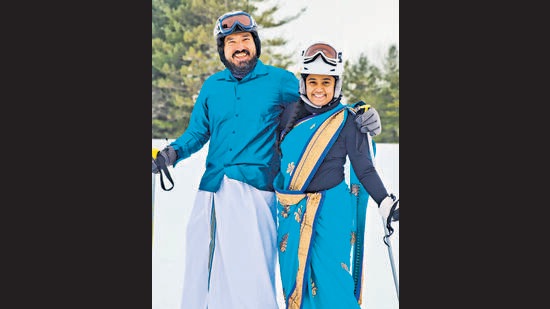
In January 2021, their mission got a boost in the most colourful way. At a ski resort, Madhu shot a quick video of Maiya skiing in a sari draped over her woollies. It seems like a cold day from the videos – Maiya’s pleats are stiff from the cold, her pallu flutters in the wind, the teal-and gold fabric is set off against the snowy white slopes. But she looks confident, even triumphant.
The couple had been skiing for years. But this was the first time they’d done it in traditional wear (Madhu was in a veshti and silk shirt). “It was for all the white people to see that other ethnicities share the slopes with them.,” Maiya says. The clips went viral, clocking up more than 1.4 lakh likes on Maiya’s Instagram (@DivyaMaiya) and getting reposted across the internet. South Asians across the world started to get interested.
The couple has gone skiing in traditional attire several times since. Maiya even wore a lehenga on the slopes recently. People now gather on the slopes to watch them. The couple has received numerous supportive comments from first- and second-generation South Asian Americans. “A lot of people told me that seeing me in a sari was powerful, and they have a different appreciation and respect for the sari and for people who wear them,” Maiya says.
One of the most touching responses to her video came from Maria Hawkins, a Native American woman from Montana, who wanted to do the same thing. “Most ski resorts are built on native land. For her it was about decolonising and reclaiming it,” Maiya explains. “I told her I just did it without asking for permission,” Maiya says. Hawkins wore her ribbon skirt and took to the slopes too.
The two skied together this February in Montana, each in their traditional outfits. “It was so beautiful because that one video brought two people from different cultures together.”
.
Rainbow wedding: ‘LGBT rights are not just for people in America’
Deepa Kollipara, 29, and Gauri Joshi, 32, who live in San Francisco, California married each other in March in a grand three-day Indian wedding ceremony. “We wanted to have a big shaadi so LGBTQ people around the world could see that just because you’re Indian and queer doesn’t mean you can’t have a happy future,” Kollipara says. What they didn’t expect is that the images of two desi brides would explode on social media.
Highlights of their wedding, posted by a friend on Tik Tok, received half a million views the day after the ceremony. Their wedding planner posted one too, which has received over 3.8 million views so far.
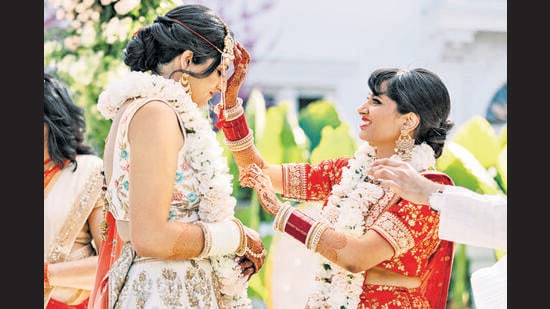
It’s a traditional Indian wedding in every sense. There was a mandap, the women took seven pheras, wore mangalsutras and sindoor, did a Ganesh pooja. “But so much of the Hindu ceremony is based on gender: the kanyadaan and the baraat. We had to modify some things,” Kollipara explains. “We didn’t want to do the baarat and establish one of us as the man because neither of us is the man.”
The couple admits that they were nervous when organising the festivities. They worried that their extended family and friends may not attend. “My mom was hesitant to invite people for the fear of negative reactions,” Kollipara says. “So I went behind her back and reached out to our family/friend’s kids, asking if their parents would be okay with coming. Shockingly, people would call my mom and say, ‘Why didn’t you tell us?’ We were overjoyed!” The ended up with 250 guests and relatives posting about our wedding on Facebook.
Messages keep pouring in from all over the world, months after event. They range from surprise: “Oh I’ve never seen this before”, to hope “I never thought I could have a future”. The most heartwarming reactions have come from young South Asians from the LGBT community, especially people from India and Pakistan who still live with their parents, and are afraid to come out for fear of being ostracised . “They write to us saying, I showed your wedding video to my mom, and she said something like, now you can marry your best friend,” Kollipara says. “There is still hope for them”.
“When I first met Gauri, she told me that she couldn’t imagine two Indian girls getting married,” Kollipara says. “I was so sad when she said that, but she had never seen it. Today she is that representation and so other Indian queer people who couldn’t imagine it before can now do so.”
.
Step up: ‘This is my way of showing my culture to the world’
Usha Jey, a 25-year-old dancer and choreographer from Paris, rose to fame online in May after her Instagram video fusing Bharatanatyam and hip-hop went viral. Jey calls the style Hybrid Bharatham. The viral video happens to be the fifth episode in the series. It has more than 4 million views. She’s gained more than 50,000 followers since.
The fame came overnight. The idea didn’t. Jey first thought of combining the two dance forms she holds dear back in 2019. “I am a Tamil woman, born in Paris. My life is a balance of cultures, just like this concept,” she says.
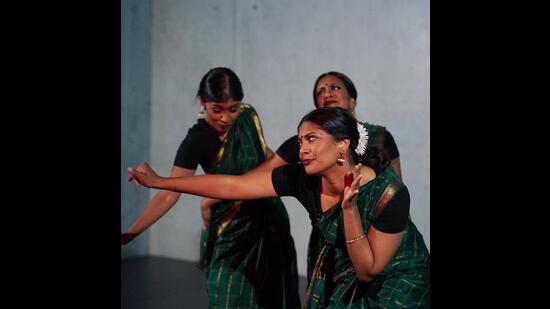
It’s exactly this balance that people have responded to in her series of videos. “They felt that I kept the authenticity of the two dance forms,” says Jey. “I understand the conservative point of view and I respect every opinion. At the same time, I know my intentions are right and I’m true to myself. I’m myself a mix of multiple cultures, and art for me is about exploring to find who you are and then expressing it. This is my way of showing my culture to the world.”
Jey has been learning Hip-hop for the last 10 years in Paris. She went to her class because her best friend didn’t want to go alone, and was hooked. The Bharatanatyam training is relatively recent. She only began learning it five years ago to stay connected to her roots.
Along the way, there have been spurts of fame. In a video from her 2020 Hybrid Bharatham series, she danced to One Hundred Thousand Flowers, a song about the Tamil Genocide in Sri Lanka, written by Canadian-Sri Lankan rapper Shan Vincent de Paul and included in his album, Made in Jaffna (2021). The song, much like Jey’s Hybrid Bharatham, alternates between two hip-hop beats and Mridangam breaks. “While I was in Switzerland for the collaboration of my last video, the two other dancers, Mithuja and Janusha, who are part of the video, and I spent many nights talking about the history of each art form, what we appreciate, and what we can question within it,” she says. It makes room for newer expressions of cultural histories that exist within a traditional cultural worldview.
.
Hot wheels: ‘If you’re bitter, don’t pass it on. Break the cycle’
Aunty Skates is not your South Asian Aunty stereotype. She wants you to follow your passion. She won’t ask when you’re getting married and why you don’t have children yet. She’s TikTok famous. And she’ll offer you skateboarding lessons in her backyard. She’s here to tell you it’s never too late to do the things you want to do.
In her original avatar, she’s Oorbee Roy, 47, from Toronto, Canada, who went viral last year for skateboarding in a sari. She’d been skating for over two years at that point, after much internal debate on whether the 40s was too late to take to the wheels. “My husband was a skateboarder. I always thought I’ll look stupid,” Roy says. “But I’d watch him and my kids skate, and I didn’t want to watch from the sidelines while everyone was having fun.”
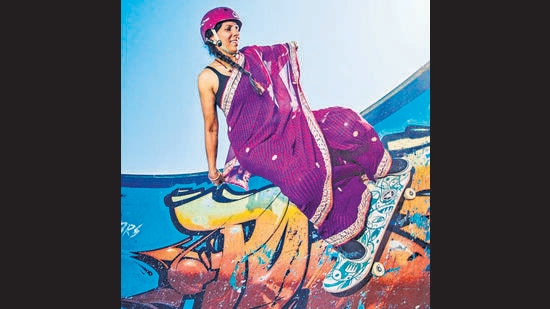
She started filming videos in 2020 in the midst of one of Canada’s worst lockdowns. “I wanted to spread joy and positivity at the very least, among my friends and family who needed it,” she says. “But it resonated with so many people on a deeper level.”
Then, in 2021 she stepped on to a skateboard, draped in a purple and gold sari, holding on to her fluttering pallu, and things went a little crazy. “It was Bengali New Year, we were under lockdown. I couldn’t visit family and was missing them,” she said. “I wanted to feel better and so I took off with my sari to the skatepark, without thinking much of it.”
Looking graceful in a sari is easy, particularly if, like Roy, you’ve learnt Bengali folk dancing for years. Mastering twists and loops on a skateboard when you’re wrapped in all that fabric, is slightly different. “I didn’t know what to expect,” Roy recalls. “There was that one turn, where I rode that first curve in the bowl — it felt so liberating, I felt like I was flying, I felt joy,” she says.
Viewers picked on that feeling of freedom. “Young people from India have written to me, saying that because of me, they told their parents that they didn’t want to go to engineering school and instead wanted to pursue music,” Roy says. “Another woman emailed me saying she wanted to go back to school to become a pharmacist because she saw me skating in my 40s and decided it wasn’t too late for her.” Parents all over North America send her pictures of their young daughters standing on a skateboard wearing a lehenga.
And she’s determined to change how South Asians view the Aunty – the judgemental older woman likely bitter from having her own dreams quashed. “Why can’t I be the aunt who lifts you up instead of bringing you down, why can’t I be the change?,” she asks. We can either continue to pass on the intergenerational trauma or stop it. That’s where Aunty Skates comes from.”
.
Dancing across borders: ‘We can connect with the world beyond words’
Suleman Malik, a Pakistani-Norwegian dancer who married in June this year got a present no one saw coming. The co-founder of the hip-hop/urban dance group Quick Style performed a Hindi-Urdu-Punjabi medley at the wedding. The songs were a nod to Bollywood classics from the 1990s and early 2000s, with the group imitating some of the signature moves and gestures of the Bollywood stars who appeared in those songs. It reached 20 million views within a few days of appearing on YouTube.
Quick Style, which Malik set up with his twin brother Bilal and their Thai-Norwegian childhood friend Nasir Sirikhan in 2005, has 200 members. They won Norway’s Got Talent in 2009, appeared on NBC’s World of Dance, and even choreographed K-pop band BTS on the songs Boy With Luv and Blood Sweat and Tears. But going viral this time hit different.
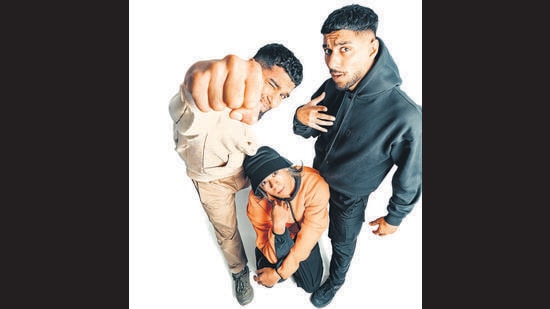
Most of the love came from South Asians, who praised their rendition of ’90s Bollywood songs such as Chura Ke Dil Mera (Main Khiladi Tu Anari, 1994), Tumse Milke Dil Ka (Main Hoon Na, 2004), and Kala Chashma (Baar Baar Dekho, 2018). “The responses were incredible,” says Bilal Malik, Suleman’s twin brother and the group’s co-founder. “We’ve had aunties and kids from India writing to us, as well as celebrities like Akshay Kumar who gave us a thumbs up.”
The crew says that the choreography was completed in a matter of three days, with the final rehearsal taking place on the day of the wedding. “It went viral because we think it’s the more real side of us,” says Bilal. “As a dancer or performer, you have different roles and vibes. This is basically our mask coming off.”
Sirikhan says that the style adopts influences from different cultures. “Growing up in a small country like Norway was not about being surrounded by blue-eyed Norwegians; it was about having a melting pot of Africans, Thais, Pakistanis,” he says. “I learned their languages, ate their food. We can connect with the world beyond words and languages through our dance and music. There are Norwegians, Moroccans, and Thais in the video. It appears that we all understand these Hindi songs, but what you see is just the joy of partaking in a South Asian wedding and its culture.”
Enjoy unlimited digital access with HT Premium
Subscribe Now to continue reading

Stay connected with us on social media platform for instant update click here to join our Twitter, & Facebook
We are now on Telegram. Click here to join our channel (@TechiUpdate) and stay updated with the latest Technology headlines.
For all the latest Art-Culture News Click Here
